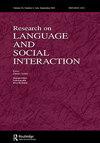如何使用连环画图形来表示签名对话
IF 2.1
1区 文学
Q1 COMMUNICATION
引用次数: 4
摘要
摘要本文探讨了以漫画为灵感的图文记录,作为一种工具,用手语,特别是挪威手语(NTS)呈现非正式多人对话中的对话视频数据。对话者的话语在言语泡沫中表现为英语翻译,而不是经过注释或语音转录的NTS,本文讨论了这种非传统选择的优缺点。为了将这种对图形转录本的探索置于背景中,文章中嵌入了对一段互动的小规模分析。摘录显示,当对话者对他们作为接受者在别处寻找时产生的话语做出反应时,对话会出现问题和修复。NTS摘录以杰斐逊启发的多语言注释文字记录的短样本介绍,然后以图形文字记录的形式完整呈现。文章的结论是,对于呈现非敏感数据,图形转录本有几个优点,例如改进了对视觉特征的访问、灵活的粒度和增强的可读性。数据采用挪威手语,并附有英文翻译。本文章由计算机程序翻译,如有差异,请以英文原文为准。
How to Use Comic-Strip Graphics to Represent Signed Conversation
ABSTRACT This article explores comic-strip-inspired graphic transcripts as a tool to present conversational video data from informal multiperson conversations in a signed language, specifically Norwegian Sign Language (NTS). The interlocutors’ utterances are represented as English translations in speech bubbles rather than glossed or phonetically transcribed NTS, and the article discusses advantages and disadvantages of this unconventional choice. To contextualize this exploration of graphic transcripts, a small-scale analysis of a stretch of interaction is embedded in the article. The extract shows conversational trouble and repair occurring when interlocutors respond to utterances produced while they as recipients were looking elsewhere. The NTS extract is introduced with a short sample of multilinear, Jefferson-inspired glossed transcript and then presented in full as graphic transcript. The article concludes that for presenting nonsensitive data, graphic transcripts have several advantages, such as improved access to visual features, flexible granularity, and enhanced readability. Data are in Norwegian Sign Language with English translations.
求助全文
通过发布文献求助,成功后即可免费获取论文全文。
去求助
来源期刊
CiteScore
7.30
自引率
7.40%
发文量
20
期刊介绍:
The journal publishes the highest quality empirical and theoretical research bearing on language as it is used in interaction. Researchers in communication, discourse analysis, conversation analysis, linguistic anthropology and ethnography are likely to be the most active contributors, but we welcome submission of articles from the broad range of interaction researchers. Published papers will normally involve the close analysis of naturally-occurring interaction. The journal is also open to theoretical essays, and to quantitative studies where these are tied closely to the results of naturalistic observation.

 求助内容:
求助内容: 应助结果提醒方式:
应助结果提醒方式:


